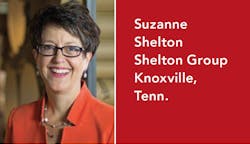Suzanne Shelton on Perceptions of Green and How to Market Sustainable Homes
A consultant once advised Suzanne Shelton that if she wanted her Knoxville marketing agency to grow into a nationally recognized shop, it should stop being a generalist and specialize. Almost two decades later, Shelton Group is a thought leader on sustainability issues, conducting proprietary research on Americans’ changing perceptions about energy efficiency and high-performance homes and sharing those insights in a weekly e-newsletter to about 8,000 subscribers. Shelton herself speaks at up to 30 national conferences annually on the topic.
Among those engagements, Shelton has been a regular presenter at the annual summit of the Energy & Environmental Building Alliance (EEBA), a building science education nonprofit. Last year, she explained that connecting prospective homebuyers with green homes is about learning how they are wired and tailoring marketing materials and messaging appropriately. She categorized prospects most likely to buy green homes as either True Believers, Concerned Parents, or Cautious Conservatives. At this year’s EEBA summit held in October in San Diego, Shelton debunked builders’ belief that buyers don’t want green homes and don’t want to pay for them.
Q: For about a decade, you’ve been saying builders should drop phrases like “high-performance home” from their marketing and use benefit terms like “comfort,” “health,” “safety,” and “resale” instead. Are builders getting that message?
A: This is a tough habit for some to break. Builders committed to high-performance building are, rightfully, passionate about the science behind it. As I said in my EEBA talk, and you guys noted in your magazine last year, Thrive Homes is the poster child for a builder that “gets it” and communicates the benefits of the science in a human, emotional, and compelling way.
Q: What’s motivating homebuyers to want energy-efficient homes?
A: The people who say they’ve purchased a certified efficient or certified green home in the past and those who are in the market for a new home and say energy efficiency is a major driver in their purchasing decision are both more likely to say the environmental impact of their energy use is their top energy concern. While past buyers are driven by preserving quality of life for future generations as a reason to buy an energy-efficient home, for future buyers it’s about saving money. Both kinds of green are important. The way to package it is that these homes are truly the best-built, smartest, and most efficient, comfortable, environmentally friendly homes on the market today.
Recommended Reading
"Shades of Green" - What is real, assumed, and imagined about how builders and buyers define and value green homes
Q: To develop a marketing pitch for selling an energy-efficient home, is it primarily about connecting with buyer demographics or is there something else with which builders should connect?
A: True Believers are a slam dunk, since they’re aware and informed about their impact on the planet, care deeply about it, and act on that belief. But so are Concerned Parents. They’re worried about their kids’ comfort and safety today and in the future. Those two consumer segments combined make up about half of the population. They’re the most likely groups to have purchased a green/efficient home in the past and most likely to do so in the future. So keep the message focused on comfort, smart, efficient, and low-impact—for your family today and for their future.
Q: In your EEBA presentation, you compared builders’ and architects’ views regarding client perception and willingness to pay for energy-efficient features with homeowners’ opinions about green. What did you find?
A: For builders to feel they can truthfully call their homes “green,” the house must have Energy Star appliances, a high-efficiency HVAC system, and higher R-value insulation, while for consumers to feel they have a green home, it has to have solar panels. Bottom line: Builders need to do all of the right things to make the home efficient and green ... but they need to add the visual cues so the folks buying the homes get to display that badge of honor and telegraph a message to anyone who visits their home that they’re people who care and do the right thing.
So add solar, even if it’s just a little, say for water heating, and consider other visible cues, like a Nest thermostat, dual-flush toilets, controllable/color-changing LED lights, and reclaimed wood paneling on an accent wall. Certifications—clearly affixed to the home—are also a good cue.
Q: What other words should home builders avoid in their marketing message?
A: I wish every builder in America were building Net Zero Energy Homes. I think that’s the right thing to do for our country. But if we’re going to call them “Net Zero Energy Homes,” we must create consistent, easy-to-understand language that gets right to the benefits of a Net Zero Energy Home. Our data says 91 percent of Americans could not confidently, correctly explain that term to a friend, and when we explain what it means, they tell us it sounds “smart” and “high-tech.” They don’t say, ‘Warm, cozy, comfortable, a place where I want to make memories with my family.” We have to overcome that with a LOT of messaging, and everyone needs to use the same messaging, so we’re not putting conflicting stories out in the market and confusing the heck out of the people we’re trying to engage.
- Access a PDF of this article in Pro Builder's December 2018 digital edition

